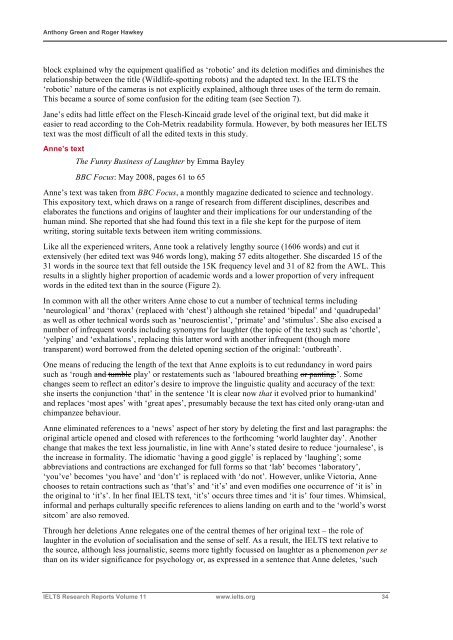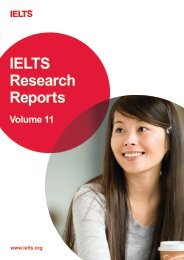An investigation of the process of writing IELTS Academic Reading ...
An investigation of the process of writing IELTS Academic Reading ...
An investigation of the process of writing IELTS Academic Reading ...
You also want an ePaper? Increase the reach of your titles
YUMPU automatically turns print PDFs into web optimized ePapers that Google loves.
<strong>An</strong>thony Green and Roger Hawkey<br />
block explained why <strong>the</strong> equipment qualified as ‘robotic’ and its deletion modifies and diminishes <strong>the</strong><br />
relationship between <strong>the</strong> title (Wildlife-spotting robots) and <strong>the</strong> adapted text. In <strong>the</strong> <strong>IELTS</strong> <strong>the</strong><br />
‘robotic’ nature <strong>of</strong> <strong>the</strong> cameras is not explicitly explained, although three uses <strong>of</strong> <strong>the</strong> term do remain.<br />
This became a source <strong>of</strong> some confusion for <strong>the</strong> editing team (see Section 7).<br />
Jane’s edits had little effect on <strong>the</strong> Flesch-Kincaid grade level <strong>of</strong> <strong>the</strong> original text, but did make it<br />
easier to read according to <strong>the</strong> Coh-Metrix readability formula. However, by both measures her <strong>IELTS</strong><br />
text was <strong>the</strong> most difficult <strong>of</strong> all <strong>the</strong> edited texts in this study.<br />
<strong>An</strong>ne’s text<br />
The Funny Business <strong>of</strong> Laughter by Emma Bayley<br />
BBC Focus: May 2008, pages 61 to 65<br />
<strong>An</strong>ne’s text was taken from BBC Focus, a monthly magazine dedicated to science and technology.<br />
This expository text, which draws on a range <strong>of</strong> research from different disciplines, describes and<br />
elaborates <strong>the</strong> functions and origins <strong>of</strong> laughter and <strong>the</strong>ir implications for our understanding <strong>of</strong> <strong>the</strong><br />
human mind. She reported that she had found this text in a file she kept for <strong>the</strong> purpose <strong>of</strong> item<br />
<strong>writing</strong>, storing suitable texts between item <strong>writing</strong> commissions.<br />
Like all <strong>the</strong> experienced writers, <strong>An</strong>ne took a relatively lengthy source (1606 words) and cut it<br />
extensively (her edited text was 946 words long), making 57 edits altoge<strong>the</strong>r. She discarded 15 <strong>of</strong> <strong>the</strong><br />
31 words in <strong>the</strong> source text that fell outside <strong>the</strong> 15K frequency level and 31 <strong>of</strong> 82 from <strong>the</strong> AWL. This<br />
results in a slightly higher proportion <strong>of</strong> academic words and a lower proportion <strong>of</strong> very infrequent<br />
words in <strong>the</strong> edited text than in <strong>the</strong> source (Figure 2).<br />
In common with all <strong>the</strong> o<strong>the</strong>r writers <strong>An</strong>ne chose to cut a number <strong>of</strong> technical terms including<br />
‘neurological’ and ‘thorax’ (replaced with ‘chest’) although she retained ‘bipedal’ and ‘quadrupedal’<br />
as well as o<strong>the</strong>r technical words such as ‘neuroscientist’, ‘primate’ and ‘stimulus’. She also excised a<br />
number <strong>of</strong> infrequent words including synonyms for laughter (<strong>the</strong> topic <strong>of</strong> <strong>the</strong> text) such as ‘chortle’,<br />
‘yelping’ and ‘exhalations’, replacing this latter word with ano<strong>the</strong>r infrequent (though more<br />
transparent) word borrowed from <strong>the</strong> deleted opening section <strong>of</strong> <strong>the</strong> original: ‘outbreath’.<br />
One means <strong>of</strong> reducing <strong>the</strong> length <strong>of</strong> <strong>the</strong> text that <strong>An</strong>ne exploits is to cut redundancy in word pairs<br />
such as ‘rough and tumble play’ or restatements such as ‘laboured breathing or panting.’. Some<br />
changes seem to reflect an editor’s desire to improve <strong>the</strong> linguistic quality and accuracy <strong>of</strong> <strong>the</strong> text:<br />
she inserts <strong>the</strong> conjunction ‘that’ in <strong>the</strong> sentence ‘It is clear now that it evolved prior to humankind’<br />
and replaces ‘most apes’ with ‘great apes’, presumably because <strong>the</strong> text has cited only orang-utan and<br />
chimpanzee behaviour.<br />
<strong>An</strong>ne eliminated references to a ‘news’ aspect <strong>of</strong> her story by deleting <strong>the</strong> first and last paragraphs: <strong>the</strong><br />
original article opened and closed with references to <strong>the</strong> forthcoming ‘world laughter day’. <strong>An</strong>o<strong>the</strong>r<br />
change that makes <strong>the</strong> text less journalistic, in line with <strong>An</strong>ne’s stated desire to reduce ‘journalese’, is<br />
<strong>the</strong> increase in formality. The idiomatic ‘having a good giggle’ is replaced by ‘laughing’; some<br />
abbreviations and contractions are exchanged for full forms so that ‘lab’ becomes ‘laboratory’,<br />
‘you’ve’ becomes ‘you have’ and ‘don’t’ is replaced with ‘do not’. However, unlike Victoria, <strong>An</strong>ne<br />
chooses to retain contractions such as ‘that’s’ and ‘it’s’ and even modifies one occurrence <strong>of</strong> ‘it is’ in<br />
<strong>the</strong> original to ‘it’s’. In her final <strong>IELTS</strong> text, ‘it’s’ occurs three times and ‘it is’ four times. Whimsical,<br />
informal and perhaps culturally specific references to aliens landing on earth and to <strong>the</strong> ‘world’s worst<br />
sitcom’ are also removed.<br />
Through her deletions <strong>An</strong>ne relegates one <strong>of</strong> <strong>the</strong> central <strong>the</strong>mes <strong>of</strong> her original text – <strong>the</strong> role <strong>of</strong><br />
laughter in <strong>the</strong> evolution <strong>of</strong> socialisation and <strong>the</strong> sense <strong>of</strong> self. As a result, <strong>the</strong> <strong>IELTS</strong> text relative to<br />
<strong>the</strong> source, although less journalistic, seems more tightly focussed on laughter as a phenomenon per se<br />
than on its wider significance for psychology or, as expressed in a sentence that <strong>An</strong>ne deletes, ‘such<br />
<strong>IELTS</strong> Research Reports Volume 11 www.ielts.org 34

















